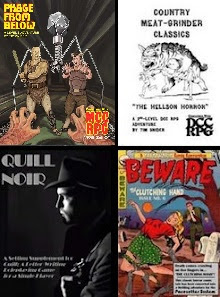Movement: 90' (30')
Armor Class: 4
Hit Dice: 3
Attacks: 1
Damage: Special
Save: L2
Morale: 7
Hoard Class: None
The Giant Stinkbug is a gigantic version of the Bygone nuisance insect. The Giant Stinkbug stands 5 feet tall and nearly 15 feet long, giving it a formidable appearance. Unlike other giant insects found in the Mutant Future, the Giant Stinkbug is a peaceful herbivore and is actually quite gentle if left undisturbed. The Giant Stinkbug is also called a Shieldbug due to the triangular shield-like shape of its carapace. The outer shell of the Giant Stinkbug also acts as natural armor, giving it a bonus to its AC.
Although the Giant Stinkbug avoids conflict, it has developed a dangerous defense mechanism if attacked -- one left over from its smaller Bygone descendants. If attacked, the Giant Stinkbug sprays out a foul-smelling musk from its thorax in a 30-foot radius cloud. Anyone caught in this cloud must save versus poison. Failure means they begin retching and vomiting for 2d6 rounds due to the horrendous odor. They will also be wracked with muscle spasms during this attack which will do 1d6 hit points of damage as they flail wildly about, desperately trying to regain their breath. This foul-smelling substance permeates the skin of the victim, and anyone sprayed will suffer a permanent -1 to their Charisma due to the lingering stink that can never be washed off or masked.
Mutations: gigantism, natural armor, toxic weapon
NOTE: The smaller cousins of these insects are ALL OVER the place around here. Figured we have giant spiders and giant centipedes in the Mutant Future, so we may as well have these damn nuisances.




.png)






.jpg)


































































Just as there are apparently some people who don't mind skunk scent, I happen not to find the scent of stinkbugs particularly objectionable -- It seems sort of wintergreen-ish to me. I'm not sure I'd say I really like it, but I think if it had been up to me, I'd have dubbed them "Aromatic Bugs" rather than Stinkbugs.
ReplyDelete